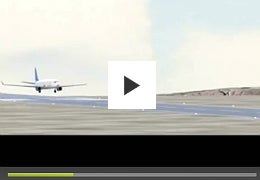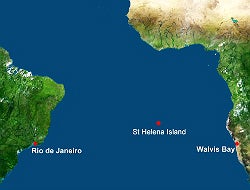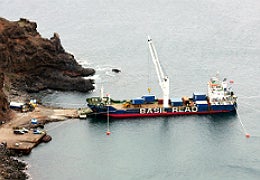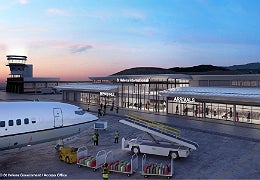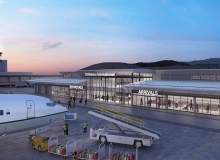
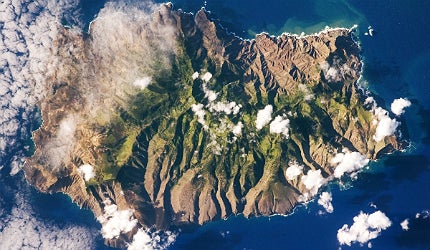
Wherever the location, developing and building an airport is never less than a massive and complex undertaking. Of course, some locations are trickier than others. Take the tiny island of Saint Helena, for example, a miniscule dot in the middle of the Atlantic Ocean described by Napoleon as "this cursed rock" when he was exiled there by the British in 1815.
Part of the British overseas territory of Saint Helena, Ascension and Tristan da Cunha, the island is a dot in the Southern Atlantic Ocean, more than 1,200 miles from the nearest major landmass.
The island’s 4,000-odd inhabitants, dubbed "Saints", are connected to the outside world by only a single vessel, RMS St. Helena, which ships goods and people to and from the island. This solitary route to the island is a potent reminder that it is one of the most remote locations in the world.
All that is set to change with the development of the island’s very own airport, being designed, built and eventually operated by South African construction company Basil Read.
The £192m airport project, funded by the UK’s Department for International Development (DFID) and due for completion in February 2016, is intended to boost the island’s economy with jobs and increased tourism, and perhaps to reverse the steady trickle of Saints leaving the island for the UK.
How well do you really know your competitors?
Access the most comprehensive Company Profiles on the market, powered by GlobalData. Save hours of research. Gain competitive edge.

Thank you!
Your download email will arrive shortly
Not ready to buy yet? Download a free sample
We are confident about the unique quality of our Company Profiles. However, we want you to make the most beneficial decision for your business, so we offer a free sample that you can download by submitting the below form
By GlobalDataHowever, with jagged terrain, limited space and the nearest major point of contact more than 1,000 miles away, Basil Read has its work cut out to bring Saint Helena its only major transport hub in its history.
We talked to Basil Read’s project director for the airport Jimmy Johnston about the unique challenges of developing an airport in such a remote location.
Chris Lo: How did Basil Read come to win the contract for the St Helena airport development?
Jimmy Johnston: The design, build and operate tender was first issued around 2006 but did not proceed due to payment terms for work that would have to have been undertaken prior to tender, not being agreed to by the bidders. A second bid was issued around 2007, where there was initial interest from several parties, but in the end only two bids were received, one from Basil Read and one from a European contractor.
After a period of around 18 months, this bid was then halted at around the start of the recession.
At the start of 2011, the two parties who had submitted previous bids were asked if they wished to continue and update their offers.
Basil Read agreed as long as all terms, conditions and the adjudication process were clear and transparent.
We updated our proposal and the bid was submitted in June 2011 after which we were declared the preferred bidder.
Negotiations were concluded in October 2011 and the contract was signed on 3 November 2011.
CL: Do you think companies were hesitant to commit to such a major project in such a remote location?
JJ: I’m sure that the size of the project and the remoteness of the island affected the interest in the initial bids and was a major contributing factor to the hesitancy in bidding. A regular question was "where is St Helena?" However, we saw the remoteness as a challenge and an opportunity where we could add value.
CL: At what stage is the project now?
JJ: I can say we’re almost fully established on the island – we have all of our heavy plant, we have all of our key personnel, we have accommodation for them – our accommodation camp is probably 70% complete. It is occupied; we’re just making it a bit larger for next year, when the production numbers will be a little bit higher. All the establishment work is more or less finished.
We started on the permanent works on the airport in October, with drilling and blasting and starting to do the earthworks up there. So that’s moving quite nicely. And the design is running in tandem with that. So design work has been ongoing since January or February this year and will continue at a reasonable pace right up until the middle of next year for the civil design.
For the airside design, we are underway at the moment, and we are having discussions in early January with ASSI [Air Safety Support International], who are the regulators for overseas territories airports. So we’re involving ASSI at a very early stage; we’re working on the process with them to make sure everybody is happy with what’s happening.
CL: How are you dealing with the logistics of transporting all the materials and resources for the project to such a remote island?
JJ: Logistics is the key to the project. The construction work is our bread and butter, all part of our normal activities in mining, roads, concrete and building works. We have employed competent and experienced design teams for the landside and airside designs.
As the logistics is the key part of the project we required to have this under our direct control. To do this, we have chartered a 78m long ocean-going landing craft type vessel that can carry around 2,500 tons of cargo, which includes one million litres of fuel below decks.
We also fitted a 40-ton MacGregor derrick crane on board the ship to allow us to handle containers anywhere on deck and offload. The ship sails on a 22-day cycle from Walvis Bay, Namibia, to St Helena and back.
Almost everything we require for the project has to be shipped the 2,000km to the island. The only main resources we get from the island are personnel, water, rock, housing and some food supplies.
Around 70,000 tons of goods have to be shipped to the island, including 20 million litres of diesel, 20,000 tons of cement, 5,000 tons of explosives and more than 100 items of construction plant.
All goods that do not form part of the works have to be shipped back to Walvis Bay. It is a big logistics challenge but I am pleased to say that after six voyages to the island by our ship, it is well under control and running well.
CL: What challenges did St Helena’s jagged landscape pose when choosing a site for the airport?
JJ: The airport position was chosen in the client’s reference design as there was limited choice due to the rugged terrain and environmental issues. A 14km access road has been built to allow access for construction equipment between Rupert’s Bay and the airport site.
The final runway level will only be decided when the quantity and quality of the in situ rock is finally known after we have carried out some more drilling, blasting and excavating. The alignment of the runway was more or less set, due to the surrounding topography.
CL: The project is funded by DFID – what have been their main priorities for the project and what has it been like to partner with the department?
JJ: DFID had several priorities, including the capability of the contractor, meeting the budget and the development of tourism on St Helena.
Due to the remoteness and the time to activate plans, the development of comprehensive risk registers, both for Basil Read and for the client, has been of paramount importance for the project.
Our own and the client’s registers are open to both parties so that we are in a position to mitigate or avoid risks wherever possible.
We’ve identified risks and we’ve mitigated risks – we’ve had plan As, Bs and Cs, which you have to do at this distance.
Working with DFID and the Project Management Unit on St Helena has been a pleasure.
We have had an open and transparent approach to the project since the negotiation period.
In a place as remote as St Helena, if you have a problem, there is no use in pointing fingers. We’ve all got to work together to achieve the common goal.
CL: What could the airport mean for the local economy and the people of St Helena?
JJ: The airport will have a huge effect on the island’s economy. Even at this stage the local economy is feeling the benefit of the construction activities.
Once the airport is operational, the effects of a major increase in tourism will be seen. This will be a trigger for the development of entrepreneurial ventures throughout the island.
Once operations start, the initial personnel required to operate the airport would be around 15 or so, with an increase on flight days, on a multitasking basis. Firemen, in addition to their primary role, will fulfil the roles of aircraft handlers, baggage handlers and maintenance personnel.
The initial key roles of airport manager, senior fire officer and senior air traffic controller will probably be expats for the first two years, but all of the fire crew and security will be Saints who will be trained at Lanseria Airport in South Africa before operations begin. As the flights increase, the staff complements of Saints will increase.
CL: Are you confident that demand for the airport will be sufficient to make operations sustainable?
JJ: We are contracted to operate the airport for an anticipated level of flights during a period of ten years. There’s a growing interest in the airport since construction started. Apart from the proposed use of an air service provider, there is interest from hoteliers with charter flights and business jets looking for easier routes to and from Europe, as I believe it will be easier to file flight plans via St Helena than across Africa, and also from business jets hopping the Atlantic.
It will be life-changing for a lot of people on Saint Helena, but I think the people don’t want to change the feel of the island. You don’t want to turn it into another southern Spanish beach resort – it has to maintain its own unique charm, while at the same time coming into the 21st century with communications and travel links.
Related content
Artificial intelligence and predictive modelling: can an airport think?
Could tomorrow’s airport systems predict passenger flows in advance, in order to alleviate the chaos of day-to-day operations?
Rolling out the holographic radar
Aveillant’s holographic radar system is poised to hit the UK market next year, offering a potential solution to radar interference by wind farms.


